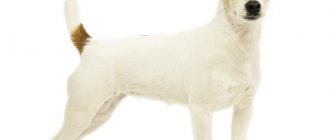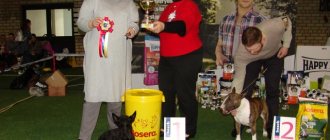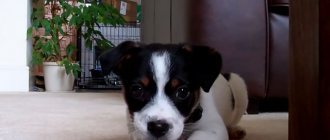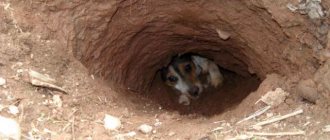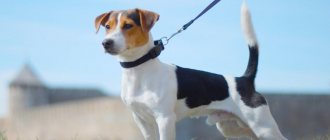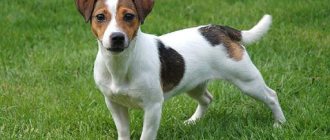Temperament
published • 11/10/2021
The main cause of behavioral problems in Russells is a lack of physical and mental activity. They need constant work or play to keep their body and mind occupied.
Ignoring this rule may result in your pet becoming an unpredictable animal whose pent-up energy will one day explode into destructive behavior.
Just like many people, Russell likes to have his own schedule. Something your Russell will look forward to.
It's a good idea to let your pet follow you around the house, as if glued to it, while you do routine things - make the bed, wash clothes, go to the store. For each new chore, come up with new commands for him to learn. For example, when you are going to sweep the kitchen floor, train Russell to fetch you the dustpan. Very soon you will find that he has become useful in carrying out the household chores, and he will be happy because he will be doing what he was born to do - working alongside his owner.
Let's look at the most common problems in the behavior of Jacks, which cause their owners a lot of trouble. All difficulties, of course, can be corrected or even prevented from occurring through proper education and training. Rest assured: there is no such thing as incorrigible behavior; there are lazy owners who simply don’t have the time to train their pet.
Barking
All dogs bark. This is one of the ways they communicate. Barking is very diverse not only in the number of sounds, but also in the number of messages transmitted. Your Jack will bark in the following cases: he needs to go outside and do his “business”; it alerts you to some situation, for example, someone is coming to the door; your Jack is hungry; he saw another dog and thus says to it: “Hello.” These are all cases of completely normal barking. Annoying barking is another matter entirely. Whenever your terrier barks for no apparent reason, it's out of boredom. If Jack behaves this way when you are at home, draw his attention to you - with your voice, with clap. Only when he stops barking do you reward him with play or a treat. If he barks outside while walking, give one or more tugs with the leash, then release the leash. When Jack is silent, reward him: you can let him off the leash or give him a treat,
Stubbornness
Jack, demonstrating willfulness or stubbornness, literally begs you to notice him.
If you yell at him and repeat the command several times, Jack gets exactly what he wanted - your undivided attention. For example, you give him the command: “Jack, drop the slippers!” He ignores you. You raise your voice, yell at him, repeat the command over and over again. Finally, grab the slippers by the free end and start pulling. Your Jack is happy - it's his day! Stubbornness certainly stems from the origin of the breed. The Jack Russell Terrier is a self-sufficient dog that knows how to make decisions, take responsibility, take risks, and insist. Every time he hears this or that command from you, Jack assesses the situation, as if thinking for a moment: “Should I accept your rules of the game? Is this or that action necessary?” He not only obeys you unconditionally, but decides whether he needs it. It seems to you that he is stubborn and refuses to obey. If you have an adult Jack who weighs your every command, this means that since childhood you have not been able to establish your dominance over him as the leader of the pack. To prevent stubbornness, build a relationship with the puppy from the very first days, as with an adult dog, develop obedience skills in the puppy, teach it commands, without waiting for it to grow up.
Origin, history, creation
The Jack Russell Terrier dog owes its origin to the English pastor John Russell, nicknamed Jack. The formation of the breed begins in 1818, when a priest purchased a bitch named Trump in Oxford. He was a passionate hunter and he bought dogs for hunting small game. “The ancestor” Trump had little resemblance to modern representatives of the Jack Russell Terrier breed. But what has remained unchanged is the color. Trump had white fur with bronze-red markings on her head and a tan patch at the base of her tail.
Purposeful crossing of Trap and her offspring with white and colored terriers led to the creation of the breed in its modern form. Some breeders even practiced crossing with bull and terriers to give the Jack Russell terriers fighting qualities. However, this was more common during the heyday of dog fighting. But after their ban in 1835, this practice began to decline, but you can still find descendants of dogs crossed with bulldogs. They can be recognized by their stocky body, wider head and lack of a clear voice.
Some researchers believe that the Jack Russell Terrier is the same fox terrier only of the old type. Considering that John Russell was among the founders of the Kennel Club, created for breeding the Fox Terrier breed, this version has a right to exist. The pastor himself never classified the dogs he bred as fox terriers, claiming that his dogs were created exclusively for hunting, while fox terriers were created for exhibitions.
After the death of John Russell in 1883, his dogs were called “working terriers”; only in the 30s of the 19th century the breed was given the name of its creator.
For what purpose was the Jack Russell Terrier breed bred?
The short-legged, miniature Jack Russell Terrier breed was bred to hunt burrowing animals. What were the requirements for the future breed:
- Short hair, since the dog's long hair would stick to dirt after being in the hole. The coated terrier significantly lost speed - the main weapon of a hunting dog.
- Light in color, preferably white, to distinguish the dog from the fox he drove out of the hole. In practice, there have been more than once cases where hunters shot at their dogs running out of a hole, taking them on a fox. Terriers were highly valued by their owners, so the breeders aimed to consolidate the white color with red markings.
- Drop ears. Standing was undesirable.
The dog bred by John Russell met all these requirements. Her character was decisive and brave. The terrier was brave and vicious towards the beast, and had a strong hunting passion. Jack Russell Terriers have been recognized as the best burrow hunters. They were used not only for hunting foxes, but also for catching badgers, rats, and hares.
Interesting! The Jack Russell Terrier has no equal in catching rodents. Thus, dogs of the breed named Vampire killed about 1 ton of rats in Great Britain in 1977.
The Jack Russell Terrier breed in modern times
Now the breed is very popular in Europe and Australia. In its homeland it is used as a hunting and farm dog. She is happily kept in houses and apartments as a companion dog. As a hunting dog, it is used to hunt foxes and badgers. But after the ban on catching badgers, hunters release them after the dog catches them. On farms, the Jack Russell Terrier does an excellent job guarding poultry and small livestock from foxes and rats.
French hunters take Jack Russell terriers to hunt feathered and fur-bearing game. The dogs bring them the shot animal. Dogs can even fetch ducks from the water. They are also used for hunting wild boar, deer, rabbits, and roe deer.
Chewing
Dogs love to chew. During childhood, they chew due to changing teeth. Adults chew because they enjoy the process itself. Of course, you wouldn't want your Jack's chewing item to be shoes or furniture. Provide your puppy with suitable chewing toys, as well as special chewing bones, there are plenty of them in pet stores. And try to limit Jack's access to shoes (just put them away). If the terrier does chew your shoe, do not yell at him. Distract his attention with a toy, and when he starts chewing it, praise him. And be generous with your praise.
Puppies
So, we have decided on the breed, it is a Jack Russell Terrier, and the puppy has been selected. What to do next? And then pure friendship begins with the most wonderful pet, a faithful and devoted friend. But a dog’s health and good mood depend on quite ordinary things.
- You need to choose a bowl from which it will be convenient to eat. It should be located at the dog's chest level, so you will need to use a stand. There should always be access to clean water.
- Accustoming to a name is one of the very first tasks in raising a puppy. In order for the dog to begin to respond to the name, you can use food. Having picked up a bowl of food, you need to affectionately call the dog by name. After several such attempts, you can modify them, for example, first call the puppy, and when he looks at you, put a bowl. Or call him, and after responding, offer the puppy an interesting game. Whatever the owner comes up with, the nickname should evoke pleasant associations in the dog.
- The Jack Russell Terrier, whose puppies are very curious, requires training to wear a collar. The little mischief-maker will be frightened by an unfamiliar object. Before you start walking outside, you can put a collar on him a couple of times and treat him with a treat. The puppy will quickly get used to the new accessory and will not be afraid of it. A leash is required during walks to ensure the dog's safety.
- The first walks are not only the beginning of getting to know the world outside the home, but also teaching the puppy to relieve himself outside. If the puppy does this, then you definitely need to express great delight and treat him with a treat so that he understands that going to the toilet outside is good. If your dog has difficulty with this, you can take a diaper with you wherever your dog goes at home.
If you arrange walks depending on the natural rhythm of the body, then the training will go much faster. After feeding, sleeping or active play, puppies most often relieve their natural needs. In a quiet place, the puppy will quickly learn to do what is wanted of him.
Anxiety from loneliness
One explanation for unwanted behavior in the Jack Russell Terrier is separation anxiety. This happens to both adult terriers and puppies. When you bring a puppy into your home, you separate him from his brothers and sisters. He is not used to being alone, without the company of his littermates and his mother. It's natural to expect him to cry and whine from loneliness, especially when you leave home. In order to distract himself with something, in this state Jack can chew furniture, baseboards, shoes, dig up the upholstery, leave puddles and piles, whine and howl. He behaves this way not because he specifically wants to misbehave or punish you. It's just his way of expressing his fear that you might not return to him. Likewise, an adult Jack may suffer from loneliness if this phobia has been ingrained since puppyhood. His destructive behavior can cause even more damage to the apartment, given the strength of his paws and adult teeth. And his loud barking or howling will cause a lot of trouble for the neighbors. Why? Yes, because Jack is trying to get out of the house and find you. He takes active steps to achieve his goal. When you get home and see a mess made, your first impulse is to punish your pet. But this is the most wrong thing you can do. Because in this case, your Jack will wait with horror for your return, but at the same time he will not stop worrying about your departure and making a mess - so you are in a vicious circle.
Here are some tips to help reduce your pet's fear of loneliness:
- Before you leave, take your Jack for a long walk.
- Provide him with a comfortable place where he can wait for you.
- Leave him a new squeaky toy and some tasty bones to chew on. When you return, put the toy away and only give it to him when you leave.
- Leave the radio or CD on
- When you leave, do not attach any importance to it in the eyes of your terrier - do not kiss him for forgiveness, and generally leave unnoticed.
- Some people solve this problem by making a friend for their Jack.
- It could be another dog. And it's best if you can afford to keep two Jacks at once.
Education and training
If you want to get an obedient and non-aggressive Jack Russell Terrier dog, you need to start training it from the moment it first appears in the house. The puppy must know its place, not only physically, but also in the hierarchy of family members. To accustom a dog to the place where it will sleep in the future, you need to wait until it gets tired of playing and falls asleep, and then carefully move it to the sleeping place. After several such manipulations, the Jack Russell Terrier will get used to its place.
The Jack Russell Terrier is a dominant dog. Despite its miniature size, in its desire to dominate family members, it is not inferior to such large breeds as the English mastiff or sea anemone. They will want to subjugate older people or children to their will, but you cannot follow your pet’s lead, and you must show through your actions that he occupies the lowest place in the hierarchy.
For the owner of a Jack Russell Terrier puppy, education and training is a way to raise an adequate dog, for which the priority will be not hunting instincts, but the owner’s commands. To prevent the dog from being a troublemaker in the house, from the first days you need to prohibit the puppy from doing things that would not be allowed to an adult dog: walking on the table where the owner works (and this place will become a favorite place for the curious terrier), hiding closets, sleeping on the beds of members family, bite. All unwanted actions should be suppressed in a stern tone, but in no case with punishment or rudeness. The main thing in raising a Jack Russell Terrier of any age is attention and a sincere attitude. Dogs of this breed require increased attention; you need to walk with them a lot, play outdoor games, and set new interesting tasks for them.
The Jack Russell Terrier does not like to be alone. When bored, he will bark and ruin things. To make it easier for the dog to bear separation from its owner, it is necessary to take it for a walk before leaving, so that during a long walk it can splash out all its energy. A treat or toy left for her will help distract her from loneliness.
How to train a Jack Russell Terrier? Training your dog should depend on your goals. Training a future hunter will be different from training a dog for shows and competitions.
Considering that the terrier is a born hunter, the owners try to develop hunting qualities: self-confidence, assertiveness, endurance, as well as obedience towards the owner. Puppies are ready for training at 10 weeks of age, but at this time the learning process should be carried out in a playful way. As you get older, you move on to serious training.
One of the main rules of training is from simple to complex. If the previous command has not been completed, you cannot proceed to the next one. Any command must be carried out 100%. If the dog understands that some commands can be ignored, this can lead to unpleasant situations in the future.
Fear of loud noises
Many Jacks, and dogs in general, are afraid of loud bangs, fireworks, and thunder.
Usually, everyone has these fears in childhood, but they disappear with age. If your puppy is afraid of loud noises, do not show concern or try to calm him down. The moment you see your pet's fear, call him to you, pet him, praise him. But under no circumstances should you calm him down or pick him up. Let him see that you are calm and do not show excitement. One of the most important skills that you should teach your Jack from childhood: in a stressful situation, he should run towards you, but not away from you, so that, frightened by the sound of fireworks or a shot, he does not rush headlong into an unknown direction. Teach this skill to your puppy from the first days in the house. It happens that this phobia does not go away with age. Never try to correct this behavior yourself. This is a genetically inherited trait that can only be corrected by a specialist, and independent attempts can only worsen the situation.
Training a Jack Russell Terrier: what not to do.
A lot has been written in books and on the Internet about how to properly raise and train Jack Russell Terriers. Therefore, today we will tell you how NOT to train and what NOT to allow your pet to do. So, TOP 10 “NOT”:
10. No matter how much they whine, first of all, NOT
Allow your little Jack Russell Terrier puppy to get used to sleeping outside of his or her bed, hutch, or other sleeping area.
You will spend many agonizing moments later trying to get him to return to his place. Also, if you don't want your Jack Russell constantly wedged between you and your spouse in bed at night, don't let him sleep in your bed. You must be strict when training your Jack Russell.
9. NOT
Let your Jack Russell Terrier often tower over you with his paws on your chest.
This may become a habit for him. Because they often like to play with him on the floor, and Jack Russells very quickly begin to experience a sense of dominance. And very soon, he is the boss! none
of the methods help convince your pet that you are the boss.
8. When disciplining your Jack Russell (hopefully you are doing this), DON'T
mix discipline with love and affection.
Don't feel guilty telling your beloved dog "NO!" DO NOT
confuse your Jack Russell with mixed emotions. He must know the difference between praise and discipline. This is important when training your terrier.
7. NOT
Allow your Jack Russell to show dominance over other dogs.
For example, there are several well-trained, larger dogs in your area, but your pet firmly believes that he is twice the size of all of them combined and barks at them. It is good if these dogs are well trained and do not react to it. Imagine when you walk with him past a poorly trained dog, three times the size of your terrier... Therefore, an integral part of training your Jack Russell should be its socialization - the assimilation of certain norms of behavior in a given situation with people and animals.
6. NOT
Allow your Jack Russell Terrier to jump up and lie on various pieces of furniture whenever and wherever he wants.
Teach your Jack Russell that you are the one who determines when it is okay for him or her to be on the couch or bed and when it is not okay for him or her to sit on the kitchen table (no joke). It is easier to train a dog correctly right away than to try to retrain it later.
5. NOT
Let your Jack Russell ride in the front seat of the car with you. There are many special dog seats that easily strap into the back seat of your car. USE THEM. Believe me, if you don’t do this, you will have a second driver sooner than you think - he will quickly “help” you with his paws on the steering wheel.
4. NOT
respond to your dog's begging even if there is still table scraps.
You just have to give in once and that’s it: Your quiet lunches and dinners at home are history (parties are history; holiday dinners are history; barbecues are possible). It happens that the Jack Russell Terrier wants to start showing various tricks on his own for the amusement of the public. BE STRONG. Remember that they are friendly by nature and are ideal show business dogs. Probably everyone knows the movie “The Mask” with Jim Carrey and his friend Jack Russell terrier named “Milo”. Therefore, to prevent your life from turning into a reality show, educate him.
3. NOT
Let your Jack Russell Terrier become the leader of the pack. Even though it has become the norm to have one pet, dogs are still pack animals. They instinctively behave as if they were in a wild environment and in a pack. If you do not want to spoil your Jack Russell, then you must become an alpha “dog” for him - the Leader, otherwise, your dog will lead you, and not vice versa. Literally, your Jack Russell Terrier will become the leader and master of the house: play when he wants; wake you up whenever he wants; pull you outside at will and do many other things that can forever destroy the peace in your home.
2. NOT
Remember that your Jack Russell is still a dog. No matter how attractive, funny and fantastic babies they are, they are not people, although they try to convince us of this. If you constantly remember that your Jack Russell is a dog, it will be easier for you to teach him that he or she is not a person. This is probably the most difficult of the tasks. Remember that your Jack Russell is a family member, but not a person. If you treat your dog like a person, he will think that he is a person, and a dog cannot have a full life like a person.
1. YES
(so,
9 is “NO” and 1 is “YES”
),
love him!
Enjoy your Jack Russell Terrier! They are full of fun, smart, resourceful, full of life, friendly, and they think this world was made just for them.
Jumping
The owner is always worried when his Jack hugs someone's leg with his paws and makes imaginary frictions. Or rides another dog. Moreover, this behavior does not depend at all on the gender of the dog. Terriers can jump on dogs of the same sex, on your legs or on the legs of guests. We often think that this behavior is caused by sexual motivation. However, this is not always the case. As a rule, jumping up means a desire to show dominance. Whether it's another dog or a person. This is a peculiar form of manifestation of your Jack’s aggression, and must be stopped immediately. If your terrier tries to ride your leg, immediately push him away and say in a firm voice, “No!” Next time you see this behavior, just turn away and walk away from him. Your Jack will soon understand what kind of behavior doesn't suit you.
The pursuit
Jack's purpose is to catch up with the animal or drive it out of the hole. Therefore, your Jack will catch up with literally everything that moves and that interests him, be it a bird, a cat, another animal, a person, a bicycle. Jack is a mobile, high-speed, addicted dog; you won’t even have time to react before Jack rushes after something that you didn’t even have time to notice. Of course, such behavior is dangerous primarily for Jack himself, especially in a city near busy highways. To avoid troubles, teach your pet from childhood to obedience and to follow the commands “Come to me”, “Ugh!” Teach your dog to return on command in the presence of any irritants. But even with an obedient and very well-mannered Jack, you need to be very careful and not let him off the leash in dangerous places.
Why do dogs mark?
When you take your pet outside to the toilet, he is busy not only with this issue, but also with a much more important matter: marking his territory.
It is an important means of communication among dogs. Watch as your Jack busily digs up the ground with his paws and marks the spot by lifting his leg. He had just left a message for his fellows: “This is my territory and I am in charge.” All this is fun to watch until Jack begins to indicate his dominance in the house and mark strategic objects: the legs of tables, chairs, corners of sofas. Some even defiantly leave piles, and always in the most visible places. What is the reason for this “unworthy behavior” of your pet? Most likely, it is caused by a change in the usual environment in the house, for example, a new person came with the smell of a different dog, a new family member, a new animal appeared. Jack thus asserts his dominance. How to behave? Of course, let your pet know that you are extremely dissatisfied with his behavior (but only at the moment when you “caught” him at the scene of the crime, and not after the fact). Give him a place where he can leave his marks with impunity. Build a pallet with a post and praise Jack when he marks the post. If you come to visit your Jack in a house where there is another dog, he will definitely try to establish his dominance and mark the corners of someone else’s apartment. To avoid such shame, introduce dogs not in the apartment, but on the street. Let them sniff each other, lift their legs as much as they need, and only then lead them indoors.
Features of the Jack Russell Terrier breed:
- The Jack Russell Terrier owes its character traits to its origin. The breed was developed by a gentleman fox hunter named John "Jack" Russell in England in the 1800s. He needed a dog with the most useful characteristics during hunting - compact build, hardy, courageous and with a certain degree of aggression.
- The Jack Russell Terrier, like many terriers, loves to dig and can dig a huge hole in a matter of minutes. It is easier to train a dog to dig when necessary than to break his habit.
- Jack Russell Terriers need to be given a large indoor space where they can play and expend their excess energy. They are known for the fact that they love to climb trees and even a yard with a high fence rarely becomes an obstacle for them, they can dig a tunnel under the fence, so it is better to control Jack’s walks on the street, even if you live in a private house.
- Timid dog owners or those who are getting a dog for the first time will make the right decision if they choose a different dog breed. Jack can be a challenge even for an experienced dog owner. He is strong-willed and requires systematic, consistent and strict training.
- Because Jack Russell Terriers can bark frequently and loudly, they are not suitable for apartment living. But he shouldn’t live outside in a kennel or in a kennel.
- Aggression towards other dogs can be a serious problem with the Jack Russell Terrier if he is not trained to get along with other dogs from an early age.
- The Jack Russell Terrier is a loving and affectionate dog, loyal and devoted to its family, and most of all loves to play with its owner. He enjoys being with people and can be a great companion for older children. When you leave home, try turning on the radio to help him cope with his separation anxiety.
- Jack Russells are lively and love to jump on people and things. They are able to jump higher than 1.5 meters.
- Jack Russell Terriers have a strong hunting instinct and can chase small animals and rodents. They should not be let off leash unless they are in a fenced area.
- Jack Russell Terriers have the highest energy levels and are constantly very active both indoors and outdoors. We can say that this is the most active dog breed. They critically need several walks a day interspersed with vigorous games or exercise in the yard.
Digging
Many dogs love to dig and do dig when they are outside.
This is normal activity. The digging instinct is present in every breed, regardless of its purpose. In this way, ancient dogs built themselves a bed from grass and leaves before settling down for the night. Jackie was especially successful in this type of activity. The origin of the breed makes Jack an excellent digger. There are funny cases where the Russells dug a hole so deep that they themselves then had to be dug out. They dig if they smell a mouse or rodent, if they want to bury their bone or toy, if they want to dig a cooler hole and hide in it from the heat. Unfortunately, this type of activity causes frustration to the owners, especially when favorite beds or beautiful flower beds with rare flowers are dug up. The upholstery of expensive furniture is often unearthed. What to do, you ask, is this instinct? Will you have to endure it? No and no again! We need to follow the path of correction. Any behavior of a dog is reinforced if it is not followed by a negative reaction, and if it is reinforced with encouragement, the behavior will be firmly established for life. From childhood on, do not allow your puppy to dig. Don't scold him for this behavior, but show him in every possible way that you don't like it. Provide him with an alternative, distract him from digging, switch to another activity.
Topics: Temperament



